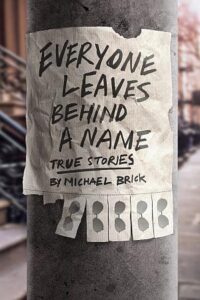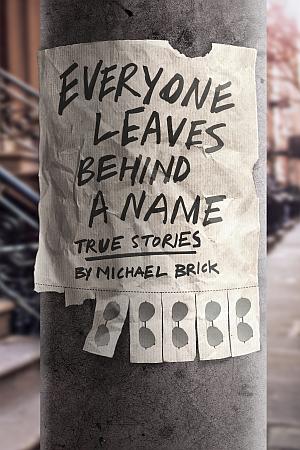This is the first of ten stories Storyboard will post from a new collection honoring Michael Brick [see our 5 Questions on the project], each featuring an introduction by a writer who loved his work. Today’s entry is introduced by Wright Thompson.
 The story of Mr. Todd Fatjo’s departure from his truly dope duplex loft is one of those rare pieces that manages to capture a subculture in a moment of transition, and were that all the story did, it would be a success. Most people wouldn’t have seen a flier and understood that modern anthropology begins, and often ends, with noticing something hiding in plain sight. In this recognition, and the mental hop-scotch from there to the wide angle lens, Michael Brick shows his reporting virtuosity. But there’s something else, a subversive undercurrent laced beneath the story, managing to both be a newspaper trend piece while also subtly poking fun at the entire conceit. The voice and language is confident, and reading it always makes me picture a young man, running flat out and roaring, in complete control. Even the use of the New York Times’ honorific isn’t perfunctory; he turns a stodgy rule of style into another weapon in his arsenal. There’s a line by singer-songwriter Jason Isbell that comes to mind when I get to the last sentence about building the city on rock n roll: “A vandal’s smile,” Isbell sings, and that’s what I imagine on Brick’s face when he finished typing this dispatch. He’d completely captured a world, avoiding the tropes so common with similar trend stories, and while evoking hipster Brooklyn and Mr. Fatjo’s transition from a DJ to “some guy with a job,” he’d left behind a finger in the eye of those who’d sling cartoons and clichés. He wrote a flawless story, while managing to spray-paint his name on the worst impulses of journalists, doing both at the same time. It is nearly perfect.
The story of Mr. Todd Fatjo’s departure from his truly dope duplex loft is one of those rare pieces that manages to capture a subculture in a moment of transition, and were that all the story did, it would be a success. Most people wouldn’t have seen a flier and understood that modern anthropology begins, and often ends, with noticing something hiding in plain sight. In this recognition, and the mental hop-scotch from there to the wide angle lens, Michael Brick shows his reporting virtuosity. But there’s something else, a subversive undercurrent laced beneath the story, managing to both be a newspaper trend piece while also subtly poking fun at the entire conceit. The voice and language is confident, and reading it always makes me picture a young man, running flat out and roaring, in complete control. Even the use of the New York Times’ honorific isn’t perfunctory; he turns a stodgy rule of style into another weapon in his arsenal. There’s a line by singer-songwriter Jason Isbell that comes to mind when I get to the last sentence about building the city on rock n roll: “A vandal’s smile,” Isbell sings, and that’s what I imagine on Brick’s face when he finished typing this dispatch. He’d completely captured a world, avoiding the tropes so common with similar trend stories, and while evoking hipster Brooklyn and Mr. Fatjo’s transition from a DJ to “some guy with a job,” he’d left behind a finger in the eye of those who’d sling cartoons and clichés. He wrote a flawless story, while managing to spray-paint his name on the worst impulses of journalists, doing both at the same time. It is nearly perfect.—Wright Thompson
A Hipster Quits Williamsburg, and Gets a Haircut
New York Times, August 21, 2004
DATELINE: Brooklyn, New York
Todd Fatjo has moved out, and Williamsburg may never be the same.
New York neighborhoods do not announce their sea changes. There is no news release or banner draped across the street. Sometimes there is just a certain guy, and a thing that guy does, and before you know it the neighborhood has made one of those subtle shifts, the sort that keep New York City fascinating.
Remember when Bill Clinton opened an office in Harlem? Or when Miguel Algarin founded the Nuyorican Poets Cafe on the Lower East Side? Or when Harvey Lichtenstein started spreading the Brooklyn Academy of Music facilities around Fort Greene?
Todd Fatjo is no former president or renowned poet, but for Williamsburg he is a tiny bellwether. In this neighborhood, bohemianism begat or gave way to hipsterism in the blink of a decade, and Mr. Fatjo was right there.
One moment, there were industrial lofts illegally housing art students who spent days at the L Cafe. The next, there was not one but two cavernous Thai restaurants, and the neighborhood kept them both busy.
And there was Mr. Fatjo, in an expansive loft far from the main drag, Bedford Avenue, knee-deep in the hoopla. He had a job at a record store, gigs as a D.J., an untamed Afro and three roommates. They held five parties during their tenancy that Mr. Fatjo would later describe as major, defined as involving three separate sound systems blaring away in different parts of the apartment.
''It was just insane,'' Mr. Fatjo said.
The telltale sign that the party was ending came in the hipster equivalent of semaphore: a flier on a wall. Inside the shopping mall on Bedford Avenue, below the flier for the dance band seeking a musician, Mr. Fatjo posted notice earlier this summer that the party-ing-est loft in all of Williamsburg was on the market.
He wrote with a simple yet passionate eloquence, speaking directly to his peers in a parlance that showed him to be of the place and moment.
''If you've ever been to my duplex loft you know how truly dope it is,'' Mr. Fatjo began. He listed some conventional real estate amenities, such as wood floors, 14-foot ceilings and skylights for a monthly rent of $2,400, then moved on to recount others that only a steeped Williamsburg hipster could appreciate:
''Popeye's and Dunkin' Donuts on the corner, about four 24hr bodegas on the corner, 2 Chinese food places next to both entrances, and it's above and across from two $.99 stores,'' he wrote.
If you have to ask why proximity to multiple 99-cent stores might be an advantage, you will never know. Mr. Fatjo's truly dope duplex loft is not in the gentrified Williamsburg of investment bankers and corporate media types. Those 24-hour bodegas he mentioned have bulletproof glass, and one sells Marlboros with Virginia tax stickers. This is the Williamsburg where a spoonful of party helps the squalor go down.
There are other things you will never know if you did not live in Williamsburg through the heydays of bohemians and hipsters, and Mr. Fatjo invoked that secret knowledge in his flier.
''Every party we've had was one for the books,'' he wrote. ''If you've been to one, you know, if not you missed out.''
Again signaling his connection to the heart and soul of modern Williamsburg, Mr. Fatjo concluded his flier with a tone of solemn inconsequence, of utter detachment from the whole matter.
''So I guess if anyone is interested leave a message or call me,'' he wrote, adding his cellphone number and e-mail address.
Lest the neighborhood be left in confusion and suspense, Mr. Fatjo tacked on a postscript hinting at what the future might hold for the young and insufferably hip.
''BTW:'' Mr. Fatjo wrote, abbreviating by the way, ''The only reason I'm leaving is because my girlfriend and myself want to get a place to ourselves and this place is too big.''
Love is a funny thing. It can spin a cynical hipster around like a record (baby, right round, round, round), and it has done a number on Mr. Fatjo, who is 28. He quit the music store this year and took a job showing apartments in Manhattan. He is working toward a broker's license, and this month he had the Afro shorn to a nice, respectable wave.
Mr. Fatjo and his girlfriend took up residence in the South Bronx, but despite all the changes in his own life, he was surprised to find that the party seems to be ending for his generation of Williamsburg hipsters. He had written the flier to help find a new tenant because he was fond of the landlord, but the hipsters he had expected never showed interest.
''I was trying to get some friends in here who were D.J.'s or artists, because you can do whatever,'' Mr. Fatjo said. ''The demand for it wasn't what I thought it would be.''
Last week, the landlord rented the loft to a tenant from another apartment in the same building, a man who had never joined the hipster parties.
''He's just some guy who has a job,'' Mr. Fatjo said.
The fate of the truly dope duplex loft may be a sign that the hipster scene is fading in Williamsburg, or who knows? Some new generation could reinvigorate the neighborhood with its own brand of cool. As for Mr. Fatjo, who is fast becoming just some guy who has a job, the end of the party is bittersweet.
''It really kills me to leave Brooklyn, especially this place,'' he said, dwelling on a last look around the empty loft. ''But doing something with my lady, that's good.''
And as for the Williamsburg hipsters, whose messages are expressed in pop culture references just as surely as they are immortalized on fliers, some might say the moral is that getting older is like skateboarding: it is not a crime. Others might just say we built this city on rock 'n' roll.



